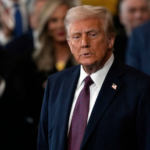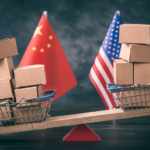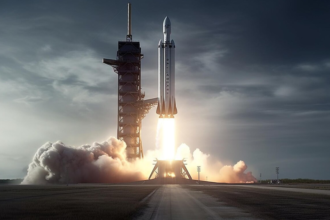China has set an economic growth target of “around 5%” for this year and has pledged to inject billions of dollars into its struggling economy. The country faces mounting challenges, including a trade war with the US, a prolonged real estate crisis, and persistently low domestic consumption. Despite these hurdles, China Economic Growth remains a central focus of Beijing’s policies.
The announcement was made as thousands of delegates gathered at the National People’s Congress (NPC), a week-long event where policies and economic strategies are discussed and formalized. While decisions are largely pre-determined behind closed doors, the event is closely monitored for key policy signals. This year’s gathering is particularly significant as China tries to recalibrate its economic strategy in response to both internal and external pressures.
How Are US Tariffs Impacting China's Economy?
China’s economy has been hit hard by the latest tariffs imposed by the United States. On Tuesday, an additional 10% levy on Chinese imports took effect, bringing the total tariff to 20% after an earlier hike in February. This move has directly impacted one of China’s few economic bright spots—exports.
China retaliated swiftly, imposing tariffs of 10%-15% on certain agricultural imports from the US, including corn, wheat, and soybeans. Given that China is the largest market for these goods, this countermeasure is expected to have significant repercussions.
Economists predict that prolonged tariffs could reduce Chinese exports to the US by as much as 25-33%. “If the tariffs linger, Chinese exports to the US could drop by a quarter to a third,” said an economic analyst from Moody’s Analytics. The impact on China Economic Growth is expected to be substantial, forcing Beijing to find new strategies to sustain momentum.+
What Measures Is Beijing Taking to Stimulate Domestic Demand?
With the export sector under strain, China is shifting its focus towards boosting domestic consumption. Chinese Premier Li Qiang acknowledged the challenge, stating, “Domestically, the foundation for China’s sustained economic recovery and growth is not strong enough.” He further noted that “internationally, changes unseen in a century are unfolding across the world at a faster pace.”
To address sluggish spending, China has rolled out programs encouraging consumers to upgrade and replace household items such as kitchen appliances, cars, and electronic devices. The government has also announced measures to put more money in the hands of ordinary citizens to reduce reliance on exports and investments. These initiatives play a crucial role in maintaining China Economic Growth by driving internal spending.
Experts argue that China’s savings culture is a significant hurdle. Due to a weak social safety net, many people prioritize saving over discretionary spending. Policies promoting financial security, better social welfare, and affordable housing could help encourage people to spend more freely, thus strengthening domestic demand.
How Much Is Beijing Investing in Economic Stimulus?
As part of its economic plan, China will issue 1.3 trillion yuan ($179 billion) in special treasury bonds to finance stimulus initiatives. Additionally, local governments will be allowed to increase their borrowing capacity to 4.4 trillion yuan, up from 3.9 trillion yuan.
In an unusual move, Beijing has raised its fiscal deficit to 4% of GDP—the highest level in decades—marking a departure from its traditional cap of 3%. This increase underscores the government’s commitment to maintaining economic stability through increased spending. These financial measures are critical to ensuring China Economic Growth in the face of global economic uncertainty.
Infrastructure projects will also play a key role in China’s economic revival, with significant investments expected in transportation, renewable energy, and technological advancements. Increased government spending is likely to spur job creation and encourage corporate investment, further contributing to growth.
How Is China Addressing Employment and the Property Market?
The government has set a target of creating more than 12 million urban jobs this year and aims to keep the urban unemployment rate at around 5.5% by 2025, compared to 5.1% last year. The job market remains a crucial factor in economic recovery, as employment rates directly affect consumer confidence and spending power.
Additionally, measures are being introduced to stabilize the troubled real estate sector, which has been a major source of economic distress. Property developers continue to struggle with high levels of debt, and consumer confidence in the housing market has been slow to recover. The government has pledged further support for the high-tech industry and is expanding elderly care programs to address the needs of its aging population.
Housing is a significant contributor to China Economic Growth, and efforts to make homes more affordable while ensuring financial stability for developers are critical. Real estate reforms, such as lowering mortgage rates and providing incentives for first-time buyers, could help revitalize the sector.
Can China Overcome Consumer Pessimism?
Despite government efforts, consumer confidence remains fragile. The aftermath of strict pandemic-era restrictions, an ongoing property crisis, and regulatory crackdowns on major tech and finance firms have left many citizens cautious about spending. With a weak social safety net, many individuals prioritize saving over discretionary spending.
Nevertheless, Chinese leaders remain optimistic. A spokesperson from the Chinese People’s Political Consultative Conference (CPCC) emphasized that while challenges such as low demand persist, “China’s economic fundamentals are stable, there are many advantages, resilience is strong, and potential is significant.”
What Role Will High-Tech Industries Play in Economic Growth?
China is placing significant emphasis on “high-quality development,” particularly in high-tech industries such as artificial intelligence (AI) and renewable energy. Investment in cutting-edge technologies is seen as a key strategy to reduce dependence on Western markets and maintain global competitiveness.
State media has highlighted firms such as DeepSeek and Unitree Robotics as examples of China’s technological advancements. The success of DeepSeek, in particular, has led to an AI-driven stock market rally, drawing renewed interest from foreign investors.
A recent commentary in a state-run newspaper stated, “China’s new energy industries and overall green transition, driven by its cutting-edge technologies, will continue to be important growth drivers.”
Will US Tariffs Derail China’s Economic Plans?
The escalation of US tariffs threatens to dampen investor sentiment and hinder China’s economic ambitions. “The chaos that tariffs leave in their wake is kryptonite for investment,” noted an economic analyst. “Tariffs are set to deliver a one-two punch to China’s economy, landing blows to both exports and investment.”
Despite these challenges, Beijing remains steadfast in its economic strategy. The government has also announced a 7.2% increase in its national defense budget, maintaining the same growth rate as the previous year.
As China navigates this complex economic landscape, its ability to bolster domestic consumption and maintain investor confidence will be critical in determining whether it can meet its ambitious 5% growth target for 2025. Sustained China Economic Growth will depend on a combination of strong domestic policies, resilience in global trade, and continued technological advancement.








